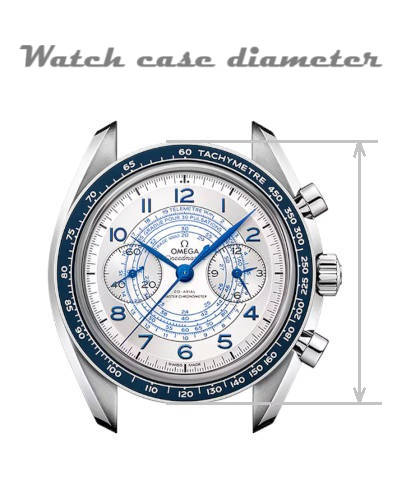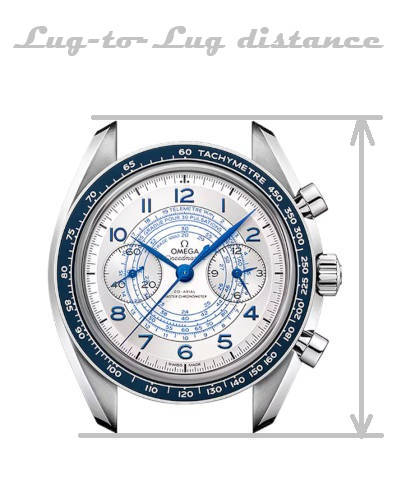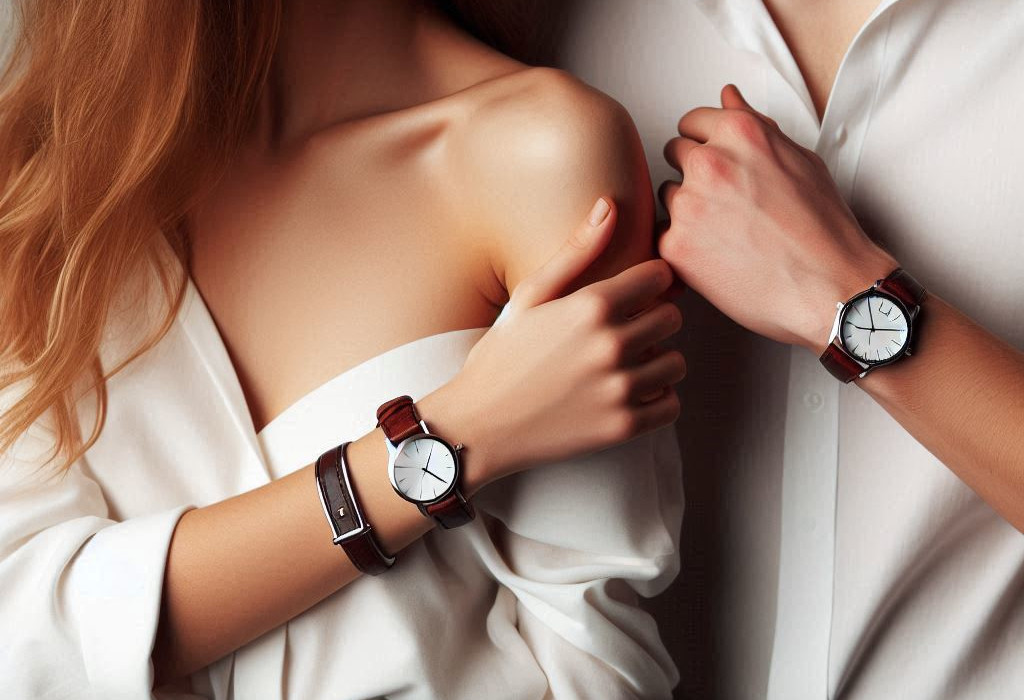1. Understanding Watch Sizes
Selecting the right watch size is more than a matter of style - it's about comfort, proportion, and how the watch complements your wrist. Whether you're into classic dress watches or modern oversized chronographs, understanding watch sizing will help you make a smarter, more satisfying purchase.
What Is Watch Size?
Watch size typically refers to the case diameter, which is the width of the watch case measured in millimeters (mm), not including the crown (the knob on the side used to set the time). It’s the most common metric used to define how large or small a watch appears when worn.

Why Case Diameter Matters
The case diameter significantly affects the look and feel of a watch on your wrist. A watch that’s too big can overwhelm a smaller wrist, while a watch that’s too small may look out of place on a larger arm. Finding the ideal watch diameter is about matching the timepiece to your wrist circumference and personal taste.
Common Watch Size Categories
Here’s a quick breakdown of common case diameter ranges and what wrist types they typically suit:
| Case Diameter | Description |
|---|---|
| Small (28–34mm) | Best for slender wrists, vintage aesthetics, or a subtle look. |
| Medium (34–40mm) | A versatile range suitable for most wrist sizes. |
| Large (40–46mm) | Great for bold styles, tool watches, or larger wrists. |
| Extra Large (46mm+) | For oversized watch lovers or very large wrists. |
Pro tip: The average men's watch today ranges from 38mm to 42mm, while women’s watches tend to be 28mm to 36mm. However, many modern designs are unisex, and what matters most is how the watch feels and looks on your wrist.
Beyond Diameter: Other Size Factors to Consider
While case diameter is important, other dimensions also influence how a watch wears:
- Case Thickness – Thicker watches may feel bulkier and sit higher on the wrist.
- Lug-to-Lug Distance – The length from the top of one lug (where the strap attaches) to the bottom of the other. A crucial measurement for wrist fit.
- Strap or Bracelet Width – Typically proportional to the case diameter; affects balance and visual appeal.
2. Measuring Your Wrist Size
Choosing the perfect watch starts with knowing your wrist size. A well-fitted watch not only looks better but feels more comfortable throughout the day. Here’s a simple step-by-step guide to accurately measure your wrist at home.
How to Measure Your Wrist Correctly
- Grab a Soft Measuring Tape: Ideally, use a flexible tailor’s measuring tape.
- Wrap It Around Your Wrist: Place the tape just above your wrist bone - this is where your watch will naturally sit. Make sure the tape is snug but not tight.
- Take Note of the Measurement: Write down the circumference in millimeters (mm).
- No Measuring Tape? No Problem: Use a piece of string or a strip of paper, wrap it around your wrist, mark where it overlaps, then measure the length against a ruler.
This simple measurement will be your key to finding a watch size that complements your wrist perfectly.
Wrist Size and Recommended Watch Diameter
Use this wrist size chart as a handy reference to match your wrist circumference with the ideal watch case diameter:
| Wrist Size (mm) | Recommended Watch Case Diameter (mm) |
|---|---|
| 130 – 155 mm | 28 – 34 mm (Small) |
| 155 – 175 mm | 34 – 40 mm (Medium) |
| 175 – 195 mm | 40 – 46 mm (Large) |
| 195 mm and above | 46 mm+ (Extra Large) |
Tip: If you’re between sizes, consider your style preference - go slightly larger for a bold look or smaller for a classic, understated style.
Why Accurate Wrist Measurement Matters
Wearing a watch that fits your wrist size ensures:
- Better comfort during daily wear
- A balanced and proportionate look
- Prevention of watch slipping or pinching
3. Consider the Watch Style
The style and design of your watch play a crucial role in how it looks and feels on your wrist. Even two watches with the same case diameter can wear very differently depending on their style, thickness, and overall design. Understanding these nuances will help you choose a watch that not only fits your wrist size but also matches your lifestyle and personal taste.
| Watch Type | Key Characteristics | Best For |
|---|---|---|
| Dress Watches | Slim, minimalist, and elegant designs | Smaller wrists, formal occasions, and office wear |
| Sport Watches | Larger cases, rugged build, often thicker with added features like chronographs and rotating bezels | Medium to larger wrists, casual or active lifestyles |
| Smartwatches | Vary widely in size and weight; often feature digital displays and tech-heavy designs | Versatile—appeal to both casual and tech-savvy users |
Why Style Matters in Watch Sizing
- Dress Watches: These tend to have thinner profiles and simpler designs, which make them appear smaller and less bulky. They’re perfect if you want a classic, understated look that sits comfortably under shirt cuffs.
- Sport Watches: Bulkier and more robust, sport watches command attention. Their added features and thickness can make them look larger, so they pair best with medium to larger wrists to maintain balance.
- Smartwatches: Size and weight vary greatly in this category. Many offer customizable watch faces and bands to adjust the visual size, catering to a wide range of wrist sizes and preferences.
Pro Tip: When selecting a watch style, think about your daily activities and wardrobe. A versatile watch that suits both your lifestyle and wrist size will serve you best.
4. Lug-to-Lug Distance
When choosing the perfect watch size, many people focus solely on the case diameter, but one often overlooked measurement is just as critical - the lug-to-lug distance. This is the length between the tips of the watch’s lugs (where the strap or bracelet attaches).

What is Lug-to-Lug Distance?
- The lug-to-lug distance determines how the watch sits across your wrist.
- Even if the case diameter fits your wrist perfectly, a long lug-to-lug can cause the watch to hang over your wrist edges, making it uncomfortable and awkward-looking.
Why Lug-to-Lug Distance Is Crucial for Comfort and Style
- If the lug-to-lug length exceeds your wrist width, the watch may overhang, resulting in an uncomfortable fit and potentially causing the watch to shift or catch on objects.
- As a general rule, choose a watch where the lug-to-lug distance is equal to or slightly less than your wrist width to ensure a secure, balanced, and comfortable fit.
Pro Tip for Watch Buyers
When trying on watches, don’t just measure the case diameter - pay close attention to the lug-to-lug measurement as well. This simple step can prevent buying a watch that looks oversized or feels cumbersome.
5. Evaluating the Watch Face and Case Thickness
While the case diameter often steals the spotlight when selecting a watch, the thickness of the watch case is just as important for both comfort and overall appearance. A watch that’s too thick might feel bulky on your wrist, while a slimmer profile can offer a sleek, refined look.
| Watch Type | Typical Case Thickness (mm) |
|---|---|
| Dress Watches | 6-10 |
| Dive Watches | 10-15 |
| Smartwatches | 10-14 |
Why Case Thickness Matters
- Comfort: Thicker watches tend to be heavier and may catch on shirt cuffs or sleeves, which can be uncomfortable during daily wear.
- Style: A slimmer watch generally looks more elegant and suits formal occasions, while a thicker case often conveys durability and sportiness.
- Wrist Proportion: Larger wrists can usually carry thicker watches without issue, but smaller wrists may benefit from thinner, more streamlined cases.
Pro Tip for Buyers
If you plan to wear your watch daily, consider how the case thickness fits under your typical clothing - especially if you wear long sleeves or dress shirts regularly. Trying the watch on your wrist and moving your arm naturally will give you the best sense of comfort.
6. Strap and Band Considerations
The choice of strap or bracelet plays a crucial role in how your watch fits, feels, and looks on your wrist. A well-matched band can elevate the entire appearance and comfort level of your timepiece.
| Factor | Description |
|---|---|
| Strap Width | Ideally, the strap width should be about half the case diameter for a visually balanced look. |
| Bracelets vs. Straps | Metal bracelets tend to make watches feel larger and more substantial, while leather or fabric straps offer a snugger, more flexible fit. |
| Tapered vs. Straight Straps | Tapered straps, which narrow towards the buckle, provide a refined, elegant look; straight straps create a bolder, more robust appearance. |
Additional Tips:
- Material Matters: Leather straps add a classic, sophisticated vibe, while rubber and fabric straps enhance sportiness and casual comfort.
- Adjustability: Metal bracelets often come with micro-adjustments to fine-tune the fit, whereas straps usually require hole punching or buckle adjustments.
- Color Coordination: Matching strap color with your wardrobe and watch dial can make your watch a seamless part of your overall style.
Choosing the right strap complements your watch size and wrist shape, making your timepiece not just an accessory, but a statement.
7. Case Shape and Wearability
The shape of a watch case can dramatically influence how it looks and feels on your wrist. Different case shapes wear differently and can alter the perceived size of your watch.
| Case Shape | Wearability & Visual Impact |
|---|---|
| Round | The classic and most common shape; wears true to its diameter, offering balanced proportions. |
| Rectangular | Often appears larger on the wrist than its diameter alone suggests, making a bold statement. |
| Tonneau (Barrel-shaped) | A stylish middle ground between round and rectangular; wraps the wrist nicely for a unique profile. |
| Cushion | Typically chunkier and more substantial; sits comfortably with a vintage-inspired aesthetic. |
Considerations:
- Wrist Compatibility: If you have a smaller wrist, round or tonneau cases may feel more natural, while larger wrists can carry off rectangular or cushion shapes with flair.
- Style Impact: Case shape contributes to the overall vibe of your watch - from sporty to dressy - so pick a shape that complements your personal style.
Understanding case shapes helps you choose a watch that not only fits well but also matches your wrist’s unique contours and your fashion preferences.
8. Proportions Based on Wrist Shape
Your wrist shape plays a crucial role in determining how a watch sits and looks. Choosing a watch that complements your wrist shape ensures both comfort and style.
| Wrist Type | Recommended Watch Style |
|---|---|
| Flat Wrists | Can comfortably wear larger watches; bold, oversized cases work well without overwhelming the wrist. |
| Rounded Wrists | Opt for proportionate case sizes to prevent the watch from overhanging; medium-sized cases offer the best balance. |
| Bony Wrists | Slimmer, lighter watches are ideal for comfort and to avoid a bulky appearance; look for thin cases and narrow straps. |
Tips for Matching Watch Proportions to Wrist Shape
- For flat wrists, watches with wider lug-to-lug distances help fill the wrist space elegantly.
- Rounded wrists benefit from moderate case diameters paired with curved lugs that hug the wrist.
- If you have bony wrists, focus on watches with thinner profiles and lightweight materials like titanium or fabric straps to reduce bulk.
By understanding your wrist shape, you can select a watch that not only fits perfectly but also enhances your overall look.
9. Try Before You Buy
Whenever possible, try on watches before purchasing to ensure the perfect fit and comfort. Visiting a store allows you to experience firsthand how different watch sizes and styles sit on your wrist.
What to Pay Attention To When Trying On Watches:
- Fit Under Clothing: Make sure the watch slides comfortably under your shirt cuffs or jacket sleeves without catching.
- Weight and Comfort: Notice if the watch feels too heavy or too light for daily wear - comfort is key for long-term use.
- Strap Adjustability: Check if the strap or bracelet can be adjusted easily to fit snugly without pinching or slipping.
Trying on multiple watches will help you understand your preferences and avoid surprises when ordering online. Remember, a watch is both a functional tool and a style statement, so it should feel just right!
Conclusion
Selecting the right watch size is crucial to achieving both comfort and style. By accurately measuring your wrist and understanding key factors such as case diameter, lug-to-lug distance, strap width, and case thickness, you can confidently choose a timepiece that fits perfectly and complements your look.
Remember, the ideal watch is not just about numbers - it’s about how it feels on your wrist and reflects your unique personality. Whether you prefer a sleek dress watch, a rugged sport model, or a modern smartwatch, the perfect fit enhances both your comfort and confidence.
Choosing the right watch size for your wrist is crucial to ensure comfort and style. A watch that's too large or too small can feel awkward and disrupt the overall look of your outfit. To complement your choice in size, it's equally important to consider the material and style of your watch strap. Learn more about selecting the perfect strap in our detailed guide on Watch Strap Materials: What Types Exist and How to Choose the Right One?.
Different watch types—such as dress, sport, or diver watches—also influence the ideal size and fit. Understanding the variety of styles can help you pick a watch that not only fits your wrist but also suits your lifestyle and fashion preferences. For an in-depth overview, check out The Ultimate Guide to Watch Types: Dress, Sport, Diver, and More.
